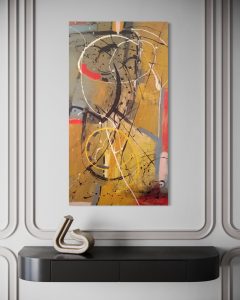
Impromptu, Spur of the Moment Acrylic on canvas 28” x 52”
Abstract Expressionism emerged in the mid-20th century as a revolutionary artistic movement that shattered traditional conventions and paved the way for the evolution of contemporary art. This avant-garde movement, characterized by its spontaneous and emotional approach to painting, not only left an indelible mark on art history but continues to influence and inspire contemporary artists across the globe. In this article, we delve into the profound impact of Abstract Expressionism on the ever-changing landscape of contemporary art.
- Breaking Free from Conventions:
Abstract Expressionism was a radical departure from the artistic norms of its time. In a post-World War II era, artists such as Jackson Pollock, Willem de Kooning, and Mark Rothko sought to break free from representational constraints, opting instead for a more intuitive and unbridled approach to their work. This rejection of traditional forms laid the groundwork for contemporary artists to explore new realms of expression and abandon the confines of figurative representation.
- Emotional Expression and the Artist’s Psyche:
At the core of Abstract Expressionism was the emphasis on emotional expression and the artist’s psyche. The gestural and spontaneous brushstrokes of artists like Pollock, in his iconic “drip paintings,” reflected a raw and unfiltered connection between the artist and the canvas. This emphasis on emotion and inner experience became a cornerstone for contemporary artists seeking to convey their own narratives and perspectives through a diverse array of mediums.
- Individualism and Autonomy:
The Abstract Expressionist movement championed individualism and autonomy, encouraging artists to embrace their unique voices and visions. This celebration of artistic independence resonates deeply in contemporary art, where artists strive to distinguish themselves through originality and personal expression. The legacy of Abstract Expressionism encourages contemporary artists to explore their inner worlds and forge distinctive paths within the broader artistic landscape.
- Expansion of Artistic Materials and Techniques:
Abstract Expressionism pushed the boundaries of artistic materials and techniques. Experimentation with unconventional mediums, textures, and tools became a hallmark of the movement. This spirit of exploration has endured in contemporary art, where artists continue to push the limits of what is considered conventional. The use of mixed media, unconventional canvases, and innovative techniques reflects the ongoing influence of Abstract Expressionism on the diverse and evolving nature of contemporary artistic practices.
- Global Influence and Cultural Impact:
The impact of Abstract Expressionism was not confined to the United States; it resonated globally, influencing artists and movements around the world. As contemporary art becomes increasingly interconnected, the cross-cultural influence of Abstract Expressionism persists. Artists from diverse backgrounds draw inspiration from the movement’s emphasis on universality, transcending cultural and geographic boundaries to create a rich and varied global artistic tapestry.
Abstract Expressionism remains a pivotal force that has significantly shaped the trajectory of contemporary art. Its legacy is evident in the freedom contemporary artists enjoy to explore new forms of expression, the emphasis on individualism, and the global nature of artistic influence. As we navigate the ever-evolving landscape of contemporary art, we can trace the roots of innovation and freedom back to the groundbreaking movement that was Abstract Expressionism.


Recent Comments